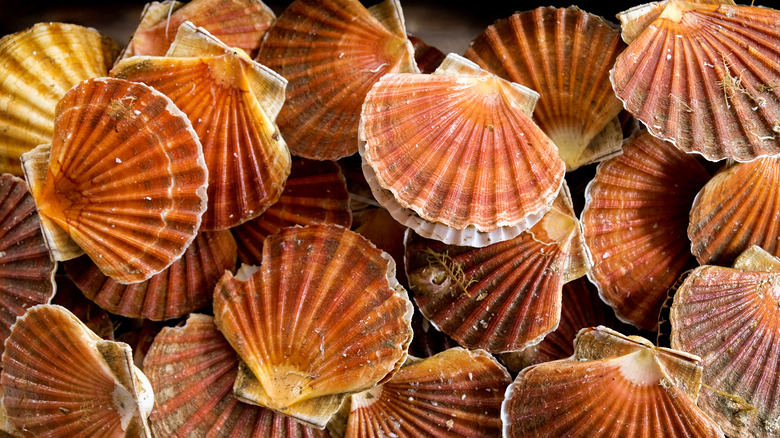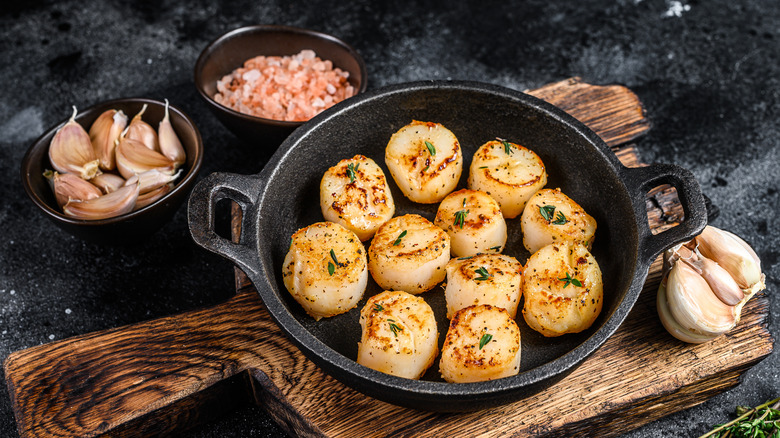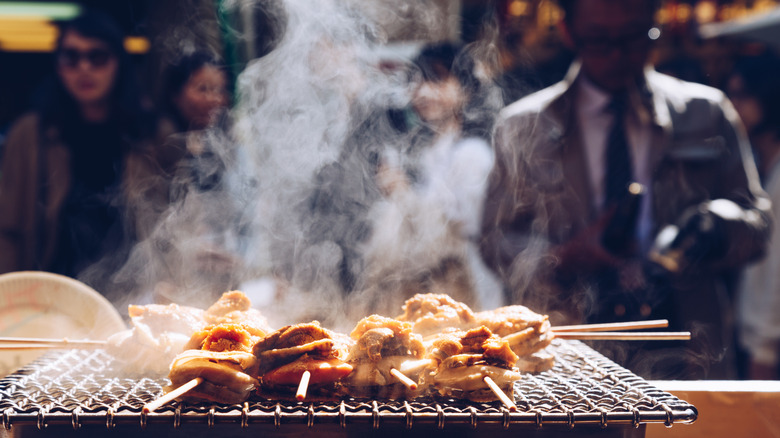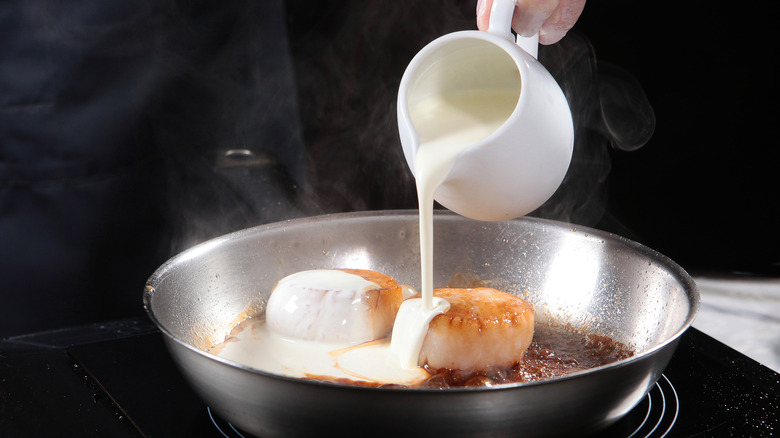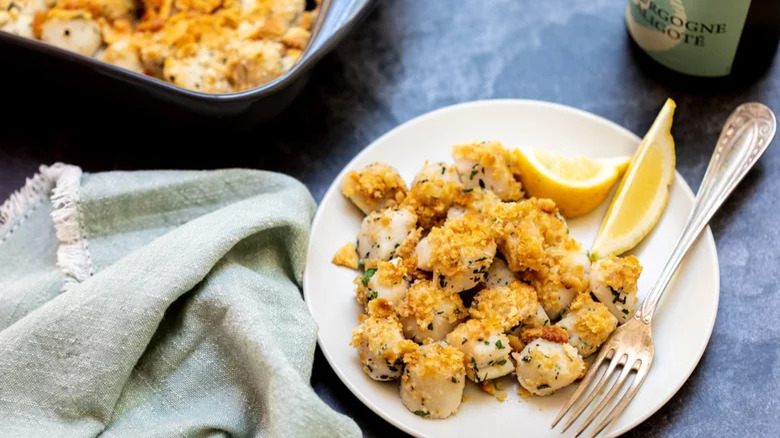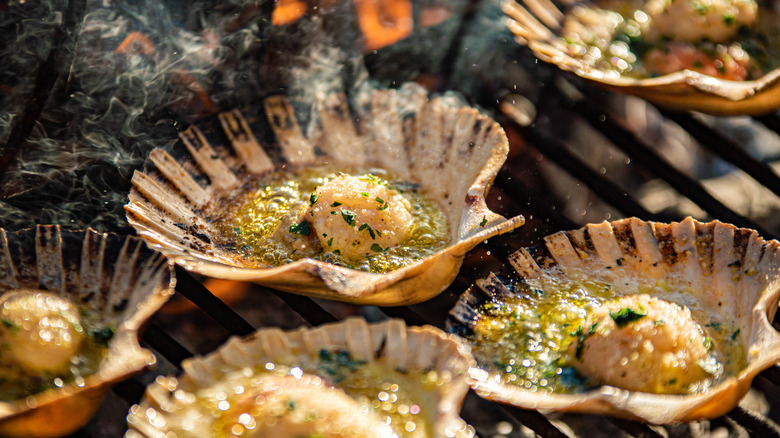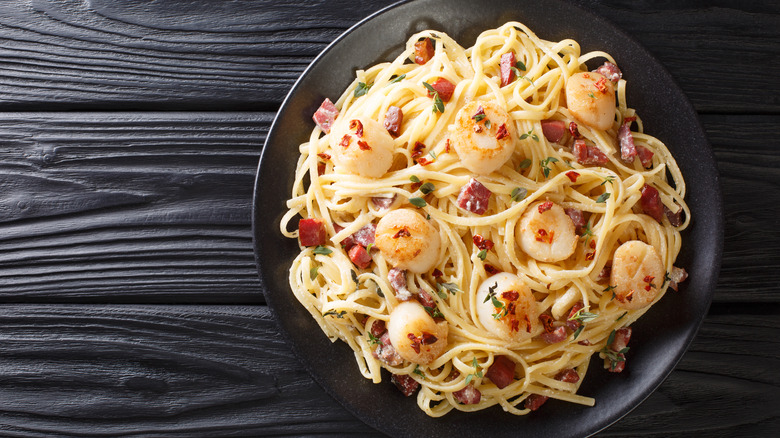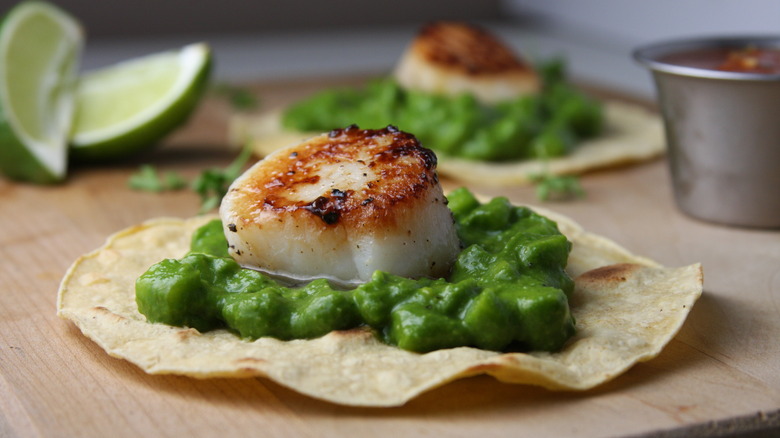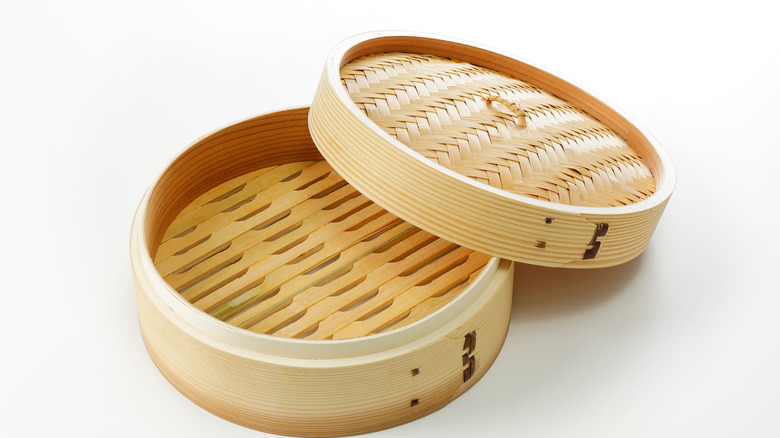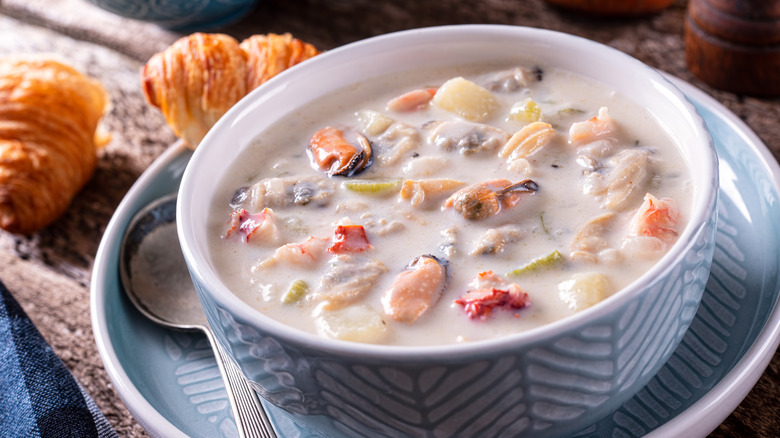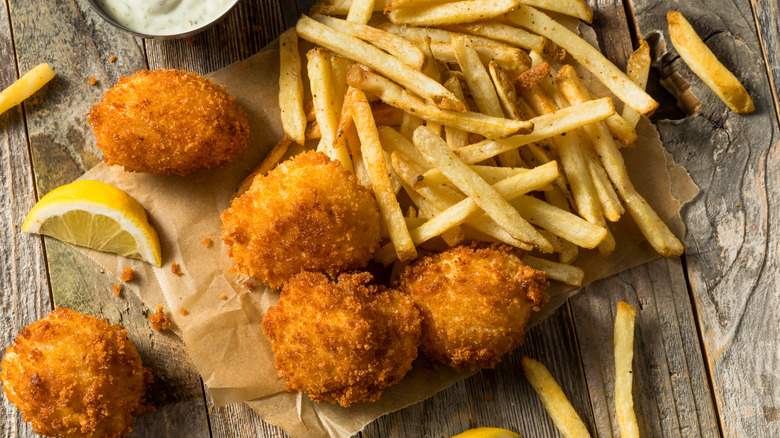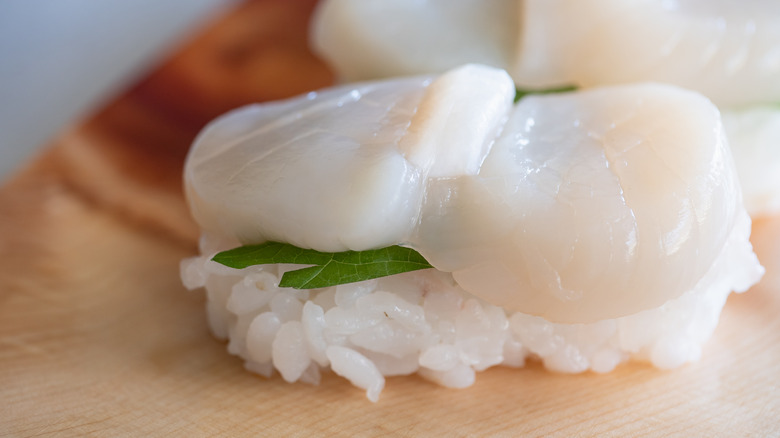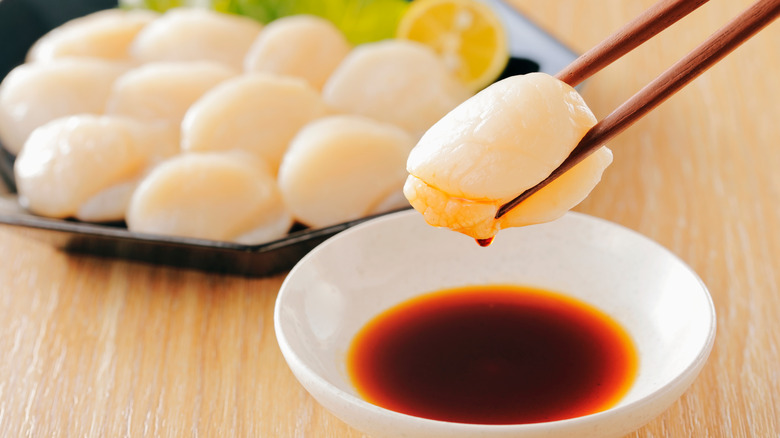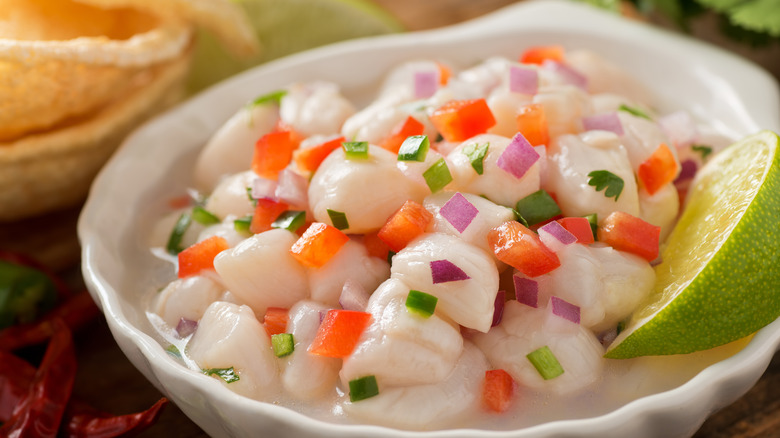Different Ways To Cook The Perfect Scallops
We may receive a commission on purchases made from links.
It's no surprise that scallops are a favorite of seafood lovers. Tender and slightly sweet, when properly prepared, they're a culinary marvel. And, with a bit of guidance, you can create restaurant-worthy scallops right at home.
Before diving (hehe) into the wonderful world of scallop cookery, a few notes on purchasing these little morsels. When you head to the fishmonger, you'll usually find two different types: sea and bay. Sea scallops are the more common of the two and are quite a bit larger than bay scallops. A pound will amount to around 20 -30 sea scallops, as compared to approximately 50-100 tiny bay scallops (via Allrecipes). While sea scallops are certainly more imposing on the plate, bay scallops are sweeter in flavor and offer a tenderer texture.
Scallops can also be purchased either wet or dry. Wet scallops are stored in a solution that keeps them fresher for longer but the downside is that they have a tendency to soak up the liquid, which reduces their flavor and naturally pleasant texture considerably. Since the solution often also contains a preservative to keep the scallops fresh, wet scallops can end up tasting a little bit soapy. Opt for dry scallops whenever possible for a better taste and texture. Now that you have some background on which scallops to buy, let's get cooking!
Seared scallops
Seared scallops are a classic for a reason. This method leads to the ideal juxtaposition of a slightly crisp crust and meltingly tender interior. To achieve this textural contrast, you need the heat to be pretty high — and that means you need to choose your oil wisely, since different oils boast different smoke points. According to Serious Eats, if you opt for an oil with too low a smoke point, you risk the fat breaking down and releasing the compound acrolein, which, as its name suggests, lends an acrid, bitter taste to whatever you're cooking. That's certainly not the flavor profile you're looking for with scallops!
Even dry scallops will be moist to the touch, so make sure to take a cue from Gordon Ramsay and pat them dry with a paper towel before cooking them, lest your scallops steam rather than sear. You may even find some recipes for seared scallops that call for dusting them with flour, which absorbs excess moisture and helps encourage the development of that sought-after crust.
Once the scallops are seared, you can season them with lemon juice or butter, the latter of which, while boasting too low a smoke point to be your cooking fat, lends a lovely rich flavor to the finished dish.
Grilled scallops
The high heat of a grill is the perfect cooking method for tender scallops, especially if you move fast. One of the biggest mistakes everyone makes when cooking scallops is over cooking them, and too much time over the flame will cause the transition from tender to rubbery in mere seconds. Just 2-3 minutes per side is enough time for the scallops to achieve that perfect tender interior and create those beautiful grill marks on the surface.
To add even more flavor to your grilled scallops, consider marinating them first. A simple combination of olive oil, garlic, and lemon juice is delicious and effortless, or you could toss some Italian seasoning and fresh herbs in for even more flavor.
Depending on the size of your scallops, you might be able to place them right on the grill without fear of losing them to the coals. If they're a bit smaller, however, best err on the side of caution and thread them onto wooden skewers (soaked in water for 30 minutes before grilling to keep them from scorching). The skewers have the added bonus of making it easy to dish out a portion. Just plate a skewer per person and add any accompanying sides — dinner is served!
Scallops in cream sauce
As with anything seared in a hot pan, scallops will quickly develop the caramelized crust that is a byproduct of the Maillard reaction: a natural browning that occurs when proteins or amino acids react with sugars after being exposed to heat. A natural flavor enhancer, the Maillard reaction is what makes seared proteins so delicious — and you can kick that flavor up to 11 by bringing up the fond that naturally clings to the bottom of the pan and using it for the base of a delicious cream sauce.
To ensure you have the best base for your sauce, CT Post offers a few cooking tips: First, pat your scallops dry, as any moisture could lead them to steam instead of sear. Next, heat the oil until it's very hot, and then, most importantly, leave them alone. "Put it in the pan, make sure you hear it sizzle, and then leave it alone. Don't touch it," Jason Baker, executive chef at The Wine Bar and Bistro, tells the outlet. He recommends keeping an eye on the edge of the scallop, and once it begins to brown, it's time to flip.
Once the scallops are seared on both sides, it's time for operation cream sauce. First, briefly sauté some garlic, and then deglaze the pan with wine or broth. Reduce it to concentrate the flavors, add the cream, and this creamy garlic scallop recipe is ready to serve!
Baked scallops
While scallops are certainly delicious when cooked over direct heat (as with searing or grilling), there's something to be said for baked scallops, too. Just as delicious, they're also a little bit less finicky.
For her copycat Legal Seafood baked scallop recipe, Molly Madigan Pisula tosses the fresh scallops in an herbed buttermilk sauce before topping them with melted butter and Ritz crackers. Just 20 minutes in a 400 F oven is all these scallops need to emerge rich, sweet, and tender. "You don't need to stand over a pan meticulously turning each scallop as it browns," Pisula tells Mashed. This means that if you're a bit nervous about overcooking your delicate, expensive scallops, baking them may be the ideal option.
Or, for a gluten-free option, combine your scallops with pepper, garlic, parsley, cayenne, and paprika, dust with Parmesan, and drizzle with butter (via Healthy Recipes). Bake for about 20 minutes and finish under the broiler for scallops that are just bursting with flavor.
Scallops on the half-shell
According to the experts at Paris' La Cuisine cooking school, the very best scallops are often sold in their shells, and in Japan, home to some of the finest scallops in the world, the shell is a common cooking and serving vessel (via JETRO).
But in the U.S., it's tougher to find scallops still in their shell. According to The Briny Babe, it is prohibited for wild scallops from Maine to be sold whole. But farmed sea scallops, usually reserved for restaurants, are available to consumers from this and some other specialized retailers, and they're absolutely delicious! Whether topped with a simple combo of garlic, panko, and white wine (via Simply Whisked) or enjoyed with green garlic, butter, and coriander (via Gourmet Traveller), scallops in their shells are a real treat that will make any meal feel like a special occasion. They can either be baked or, in a nod to traditional Japanese street markets, grilled over hot coals. Either way, be sure to serve lots of crusty bread for mopping up any sauce or juices that collect in the shells.
Scallop pasta
Scallops are definitely delicious, but given their expense, you may want to consider having them share the spotlight with another substantial ingredient. To turn scallops into a more filling meal, simply serve atop or stirred into pasta. Coated in Cajun spices and perched on a mound of tomato-y spaghetti, they're just the ticket.
Bay scallops are the perfect base for scallop alfredo, as the bite-sized morsels are easily tossed through the fettuccine. Searing the scallops forms the base of the sauce, with the fond from their caramelization adding a depth and richness to the onion, garlic, cream, and Parmesan. And don't let naysayers try to convince you that cheese and seafood should never mix! Turns out, according to Atlas Obscura, that this is a myth that may have surfaced from Aristotle's understanding (or lack thereof) of the body's digestion, or may have come about due to the fact that many of Italy's top cheese producing regions are landlocked. Either way, we say bring on the Parmesan!
Scallop tacos
Another great way to get pair other ingredients with scallops is to serve them in tacos. After all, one sea scallop is kind of the perfect size for a traditional corn tortilla, and two or three tacos (and thus, scallops) per person is the ideal portion for a delicious and filling dinner.
Pile seared scallops, homemade guacamole, and fresh mango salsa into corn tortillas and garnish with thinly sliced red cabbage and jalapeños for color, crunch, and spice. Consider swapping in grilled scallops and top them with smashed avocado and a charred corn pico de gallo for even more richness and depth of flavor (via MyRecipes). You could also serve your scallop tacos with a more classic tomato-focused pico de gallo or even pair them with a creamy pineapple coleslaw. The bright purple color of the red cabbage and pleasant acidity of the pineapple is sure to make the scallop tacos pop.
Steamed scallops
While searing, grilling, or even baking scallops is the key to a beautiful caramelized crust, there are some instances where you might want a gentler cooking method. Indeed, steaming scallops allows the tenderness of the mollusk — not to mention its natural, milder sweetness — to come centerstage.
In their book "China: The Cookbook," Kei Lum and Diora Fong Chan drizzle in-shell scallops with a garlic-infused oil and top them with scallion and red chile (via Food & Wine). Steamed in a bamboo steamer, they emerge plump, soft and oh-so tempting!
Serve these steamed scallops with a simple, Chinese-inspired side dish like sautéed bok choy or Chinese broccoli, aka gai lan. These members of the cabbage family, per Diversivore, are rich in sulforaphane, an immune-boosting nutrient that may soothe general inflammation and even reduce the risk of certain cancers (via Organic Authority). Plus, their light bitterness will bring out the natural sweetness of the scallops themselves.
Scallop stew
Clam chowder may be the best-known member of the category of creamy, seafood-based soups hailing from New England, but it is far from the only one. Indeed, the region along the Eastern Seaboard of the United States boasts a historic richness, not only of clams, but also of oysters and, yes, scallops (via The New York Times). According to Fearless Eating, no mollusk or crustacean big or small has resisted being stewed in one of the region's specialties: a creamy, brothy base.
The American scallop industry's capital still remains New Bedford, Massachusetts, home to the most scallops in the nation "by far," according to WBUR, so it's the perfect place to source the scallops for a traditional New England scallop stew. For Fearless Eating, this specialty marries scallops with broth and milk or cream for a rich, hearty soup that can easily be enjoyed as-is or livened up with spices or even butter. The outlet specifically cites a recipe from "Clam Shack Cookery," penned by fisherman Phil Schwind, that calls for serving the stew "in hot bowls in which have been placed chunks of butter as big as walnuts."
Deep-fried scallops
Battered and fried scallops are yet another New England specialty, found frequently at roadside clam shacks throughout the region. According to ConnecticutHistory.org, seafood shacks date to the early 20th century in the region, and today, they're a local staple, with regular coverage in outlets like the Boston Globe which attempt to suss out the very best of the bunch. While fried clams, the outlet claims, are often the best selling option, these stands also peddle fried shrimp, fish, and, of course, scallops.
While there's nothing quite like a hot portion of fried scallops served from one of these roadside huts, if you're far from New England, you can recreate them at home by seasoning bay scallops (or sea scallops cut into quarters) simply in paprika, salt, and pepper, and encrusting them in a simple, three-step breading of a flour dredge, beaten egg loosened with milk or water, and breadcrumbs (via The Spruce Eats). Fried in 350 F vegetable oil for just a minute or two, they emerge crispy on the outside and tender within. Yet another option calls for coating the scallops in a beer batter before deep-frying them. A portion of homemade french fries and a ramekin of tartar sauce are the perfect finishing touches!
Scallop sushi
While you certainly can cook scallops in many different ways, the best quality scallops demand an even simpler preparation: no cooking at all! Indeed, according to Sushi Everyday, scallop sushi — aka hotate — is a true luxury you'd be lucky to experience. Sea scallops can be turned into nigiri, that simple sushi piece comprised of seasoned sushi rice topped with a perfect portion of protein, while bay scallops are ideal for gunkan-style sushi, where an oblong case of nori surrounds a layer of rice topped with a seasoned fish or seafood topping. Looking at them, it's no surprise that their name, according to the outlet, means battleship in Japanese!
Scallop sushi can certainly be enjoyed as-is with no further adornment, but Just One Cookbook also suggests topping each piece with yuzu-flavored tobiko (aka flying fish roe), spicy mayonnaise, or fresh chives. Add a touch of wasabi and a gentle kiss of soy sauce, and this specialty is ready to be enjoyed.
Scallop sashimi
Take simplicity one step further by foregoing the rice and making scallop sashimi instead. Arm yourself with a good Japanese chef's knife, and do as Fine Food Specialist recommends: Carefully cut the raw sea scallops into three thin slices, and season them with a balanced blend of soy sauce, lime zest and juice, sesame oil, coriander, shiso, and wasabi. Or follow the even simpler preparation suggested by Maggie Beer, and season the scallops with flaky sea salt, pepper, olive oil, lemon juice, and fresh herbs.
As with any time you dig into raw seafood, when enjoying scallop sashimi, quality and freshness are of the utmost importance. Seek out sashimi-grade scallops from your local fishmonger, and buy them the day you plan to enjoy them. According to eHow, if the scallop has taken on a brownish color or a fishy aroma, this is a sign it's past its prime.
Scallop ceviche
The Japanese are not the only ones who enjoy their scallops raw (or make that raw-ish). Ceviche, which is popular in Mexico, Peru, and other Latin American countries, is a method of preparing fish or seafood that "cooks" it, not with heat, but with acid. Small bay scallops are ideal for this dish, which marries the mollusks with the juice of both limes and lemons as well as chile peppers, red onion, and cilantro.
When it comes to ceviche, the most important factor is undoubtedly timing. Beginning the marinating process too soon before serving will leave the seafood totally raw, but leaving it in the marinade too long will leave you with something overcooked, dry, and far from appetizing. According to Caroline's Cooking, two hours is the perfect marinating time for little bay scallops to be tender yet opaque. Serve them with plantain chips for the ideal textural contrast.
